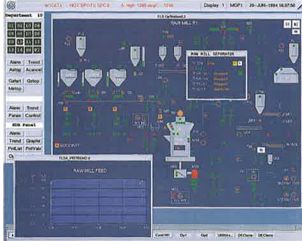FLS Automation emerged from a small R&D depart- ment within the F.L. Smidth Group over 25 years ago.
As automatic process control and supervision systems became increasingly important components of the cement and mineral works being built by the company, FLS Automation activity kept pace. Today, FLSAutomation is a thriving independent company, one of five members in the F.L Smidth-Fuller Engineering Group.
With a reputation as one of the world’s most innovative process control specialists, FLS Automation offers a range of control and process optimization systems, including hardware integration, software and engineering services, as well as process control and optimization software.
Headquartered in Denmark, FLS Automation also has offices in the United States, Spain and France and maintains close contact with the worldwide network of F.L. Smidth-Fuller Engineering Group companies.
The latest generation of FLS Automation’s Expert Control and Supervision (ECS) systems includes .the ECS/ OpStation, an X Windows-based Man Machine Interface (MMI). The ECS/OpStation provides a cement plant operator with an animated, real-time view of the plant with point-and-click control of the facility’s motors, PID set points, shutters and other devices. The open platform allows the configuration to meet each plant’s unique specifications, as well as efficient integration with any FLS Automation plant optimization and quality control system. FLS Automation is committed to developing and integrating leacling-eclge technology to meet customer requirements. True to this philosophy, the company has incorporated SL-GMS software to provide users with a dynamic, real time, MMI, plus the open, object-oriented characteristics that are vital to developers.
The ECS/OpStation is hosted on a Digital workstation under OpenVMS. The system utilizes a real-time, proprietary database which is continuously communi cating with the plant’s operation through Programmable Logic Controllers (PLCs). The PLCs gather status data into logical groups before sending it, together with analog data, to the database. These units of information, called Motor Status Words (MSW), facilitate real-time communi cations throughout the plant’s control system and advanced dynamic presentations on the ECS/OpStation.
The operator uses the MMI to supervise and control the production facility. The objects on the screen mimic the actual devices on the plant floor, such as hoppers, mill feeds, motors, conveyors and switches, as well as all analog measurements. In addition, text data identifies the devices by name and numerical data presents current
operational statistics. All of the screen displays have been built utilizing the SL-GMS software and as a result change dynamically in real-time to reflect the current state of the process. The display is updated as each MSW and analog data is received by the database. Flashing and color changes in the displays are also used to communicate state data to operators. For example, when a motor is running, the object representing the motor onscreen will be green. The screen object will turn reel and flash to indicate an alarm. Once the operator acknowledges the alarm (using point-ancl click mouse function), the motor objects stop flashing, maintaining a static reel to indicate an acknowledged but pending alarm.
At other stages in production, operators interact with Lhe process by changing set points for a !’ID loop. In this Lyp<: of situation, the operaLor clicks on a dynamic screen object and the MMI pops up :1 template which includes the PII) control mode, the process and the output variables, plu.'i slide bars ancl hutlons to adjust the set point. From the template, the operator also initiates display of trend curves, showing all of the oulput and set points that are related to that PI!) loop. The template is based on SL-GMS and therefore changes in re:d-tirne to ref1ect current conditions and operator actions are transmitted immediately to the control devices. The intuitive, easy-to-use nature of the MMI results in improved operator performance and reliability and minimizes the risk of equipment damage and production loss. The multi-tasking X-Window environment reduces the number of control-room operator workstations, cutting the investment withoul sacrificing functionality. Operators open several windows on a single display, each high lighting a different portion of the plant. In a typical example, two main windows are configured as a process overview and a display of the plant's motm systems. This configuration provides a view of the overall process and each of the subsystems within the process. Older control systems relied on different operator interfaces for each suhsy.-;tem, requiring that opcr,ltors become proficil:nt on several MMJs. Hy integrating all of the plant's subsystems into a common MMI, FLS Auto-mation has significantly reduced the operator training and system maintenance requirements.
The operator displays were created utilizing the SL-GMS editor, SL-DRAW2. The editor’s ohjeet-oriented 1pproach allows cleveloper.’i to create a single screen object and then instance it to generate as many copies as neeclc.::cl. More complex group objects can he rapidly built by combining individual items. If a change is made to the object, it will also he reflected in all instances of the object. This dramatically reduces the time required to create ancl change complex displays. The individual SL-GMS generatecl objects retain their dynamic properties when usecl in a group object, therehy eliminating reclunclant programming effort. Further, the SL-DH.AW2 editor includes the capability to assign the dynamic properties to the screen objects ancl then link them to the database aml the control devices mimicked by each screen. This simplifies the setup of displays at each new customer installation.
FLS Automation engineers investigated several alternatives for generating the sneen displays and selected SL-GMS.
The functionality and ease of use of the SL-DHA W2 editor allowed them to focus on the firm’s core businesses – system integration, process control and optimization – rather than the complexities of graphical interface progress. In acldilion, the open architecture of SL-GMS allowed some of the objects from previous generations of FLS Automation products to be seamlessly integrated into the new system.

Switch to a smarter, more flexible and easy-to-use graphical modeling software.
Try SL-GMS